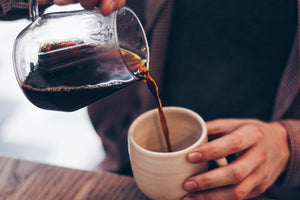If you're anything like the Hoxton Coffee team, you'll love the jolt of energy and alertness you get from a seriously strong cup of coffee in the morning (especially on a Monday!).
However, coffee strength is massively misunderstood.
Just because a bag of beans shows off an impressive-looking strength rating, that doesn't necessarily mean you're getting a beautifully smooth cup of espresso that'll give your sleepy brain a run for its money.
Today, Hoxton wanted to explain the science behind our best-selling Proper Strong coffee - and why it really is one of the most powerful brews money can buy!
What Does the Coffee Strength Mean on a Bag of Beans?
There's a big difference between the darkness of the roast and the level of caffeine in your coffee; this is the most common misconception.
The Hoxton Coffee Roasters will be quick to point out that the number scale is, at best, a little bit arbitrary, and it's more to do with marketing, and flavour profiles than strength, as we understand it.
So, just because your beans say they're Grade 5 Coffee - or even six or seven - they might just be darker and more bitter than another cup.
As a quick rundown:
- The grade of the bean means how strong the roast is; nothing to do with caffeine.
- The taste and flavour are richer and more robust but sometimes pretty bitter.
- Very dark roast beans can be of terrible quality (but it's disguised by an acrid flavour!).
If you're one of our loyal Hoxton Coffee drinkers, you'll know that we're all about exceptional quality and created Proper Strong as an antidote to the coffee fake-it-till-you-make-its that don't have the bold caffeine levels we prefer.
What is the Definition of Proper Strong Coffee?
The real strength of a beautiful bean is in the caffeine kick you get per sip.
So, if the numbers on the bag don't mean much, how can you calculate how much caffeine you're getting and work out which bean is the perfect pick me up?
A technical answer would be to look at the weight of dried coffee beans used and the caffeine concentrate per gram and then extrapolate that by the volume of water.
However, we're assuming you're not heading into your local coffee shop or making your morning brew with a set of digital weighing scales and a calculator to hand!
Instead, it's easier to consider the brew behind the blend (or the 100% Robusta we use in our trademark Proper Strong).
Any commercially produced coffee will contain between 0.6% and 1% caffeine per gram, and you'll want to double those numbers when we're talking about a 100% Robusta - you can see where we're going here!
Something like 60% of all the coffee produced globally is Arabica. Although it's often a little pricier as a raw ingredient, it's also a weaker bean in terms of caffeine content.
On average, 10 grams of Arabica contains about 100 mg of caffeine, although that can vary depending on the density of the grind and a few other factors.
Robusta is the all-powerful coffee that produces the maximum hit, with double the caffeine of Arabica and a punchy, deep flavour that hits just where you want it - and that's why we use it in Proper Strong!
Wherever it sits on the scale, the darkest roast produced with Arabica will taste strong, but it won't be strong.

How Can I Make the Strongest Possible Cup of Proper Strong Hoxton?
We wanted to share a few tips to ensure you make the most of your new bag of fresh Proper Strong beans - and the secret is all in the grind.
Now, you don't need to be a coffee connoisseur to prefer the convenience of making coffee at home. Still, these same guidelines apply to baristas, bakehouses and coffee shops, so it's worth knowing!
Most of us make coffee like this:
- Open the bag of beans (taking a lovely big lungful of the coffee scent).
- Check a rough amount of beans into a grinder.
- Press go and pop the grounds into our cafetiere, coffee filter machine or espresso maker.
There's nothing wrong with the routine, apart from where you don't adjust your grinder.
A really quick cheat is just to use a greater physical amount of beans in a cup, but if you'd like to keep your hair on, changing the grinder settings will ensure a smooth consistency without losing out on strength.
A professional grinder might have micro-fine adjustments, but even an automatic machine will normally have several levels you can select.
Why Does My Proper Strong Espresso Taste Weak?
Every new bag of beans you open is pressurised, so ideally, you want to leave your bag open for a little while, so the beans reach an equalised oxygen balance with the air around them.
Very coarse grinds or low dosages mean that your espresso machine fills your cup quicker, but you'll get a weaker coffee.
Because each chunk is larger and rougher, the water won't have maximum exposure, and so you get a thinner body, less sweetness, inconsistent bitter notes and a lack of flavour.
It's called under extraction, and you get a paler crema on the top.
Your beans aren't at fault, but your grind is too big, so you need to play with those settings.
Why Does My Proper Strong Coffee Taste Sour?
The opposite happens when you set your grind too fine, which often means your coffee burns because it's in contact with hot water for too long - you'll get a sour essence and the coffee tastes 'baked' - again, it's all in the grind.
Our advice is to look at your grinder, work out roughly how much coffee you're using per cup, and experiment until you find the magic sweet spot.
It's well worth the time if you're vested in having an authentically strong cup of coffee each day and one that carries just as much mighty caffeine as it does that uniquely rich flavour coffee lovers crave.

